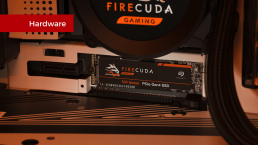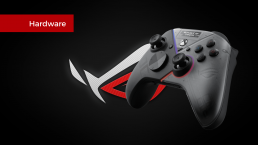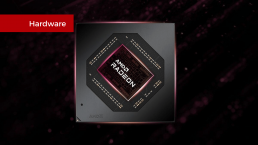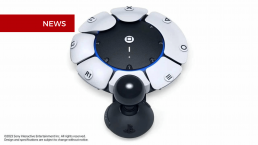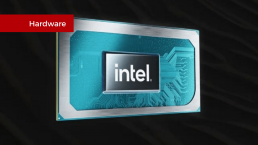Hardware | PlayStation Portal
The PlayStation Portal will be released this week. Sony's new streaming handheld makes it possible to play PlayStation games remotely over the Internet.
What are the PlayStation Portal release date and price?
The PlayStation Portal is now available for around 219.99 euros.
What is the PlayStation Portal?
In short, the PlayStation Portal is a compact screen that allows you to stream games from your PlayStation 5 via WiFi. On either side of the screen are two half DualSense controllers. So the Portal does not play local games.
The PlayStation Portal is a handheld with an 8-inch screen. The device has an LCD panel with a resolution of 1920×1080 pixels and a refresh rate of 60 Hz. ‘Half’ DualSense controllers are placed on both sides, as if a full controller was cut in half. This controller is identical to the regular DualSense controller in both functionality and feel, with adaptive triggers, haptic feedback and all conceivable buttons.
No other notable technologies are hidden in the housing of the PlayStation Portal. According to several hands-on previews, the Portal only has a settings menu that lets you connect to a Wi-Fi network. Although it seems like only a matter of time before the Portal is cracked, only Remote Play is available upon initial deployment.
What is possible with Remote Play?
Remote Play offers complete control over a PlayStation 5, but remotely. All the usual actions are possible, such as playing games, switching between games, adding friends, sending messages, taking screenshots, downloading games, and more. Think of Remote Play as a Chromecast from a PS5 to the Portal (or phone).
The Portal also has an aux port for connecting wired headphones. Unfortunately, Bluetooth is missing, making wireless earphones unusable. That is a significant loss for many users, especially given the large presence of wireless headsets and earphones in 2023. Sony may have omitted Bluetooth because of the delay it entails, such as on the Nintendo Switch.
What is not possible is streaming games that are not installed on the PS5. This includes the classic titles available for cloud gaming with a PlayStation Premium subscription.

Where can the Portal be used?
Remote Play works when the Portal can connect to a stable Wi-Fi signal. Sony’s only stated requirement is a “broadband WiFi connection of at least 5MB/s”. So there is no need for the same WiFi connection as that of your PS5.
The Portal’s Wi-Fi connection does not have to be the same as the one to which the PlayStation 5 is connected. As always, when streaming games: as long as the internet connection is stable. Sony indicates that an internet speed of 5 MB/s is a requirement, but 15 MB/s is recommended. Practice shows that playing at 5 MB/s can be considered ‘playable’ at best. The connection works well from 10 MB/s.
The Portal does not support 4G or 5G, but it can connect to your phone’s hotspot.
Does the PS5 need to be on to use Remote Play?
At home and in the vicinity of the PlayStation 5, it is possible to activate the console with the Portal while it is turned off. This is because the Portal works as a full-fledged PS5 controller, with the necessary wireless protocols to communicate with a powered-off PS5. That is a functionality that is missing on a phone. The Remote Play app must communicate with the PS5 via the internet to start it.
So with both the phone and the Portal (when not near the PS5), the console must be in sleep mode to turn it on remotely. Once turned on and connected, Remote Play is intelligent enough not to turn the television on automatically; it remains disabled.
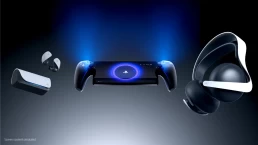
But isn’t this also possible with a mobile phone?
It is often noted on the internet that most people do not understand why the Portal even exists. It is stated that a phone with an attachment controller can do the same as the PlayStation Portal. The Remote Play setup can be simulated with a cheap attachment for your phone.
However, such an attachment has some disadvantages. For example, things like phone calls, receiving important emails, or simply the need for battery life for the rest of the day can cause interruptions to the gaming session. In addition, it is better to connect the controller to the phone with a cable, as Bluetooth can cause significant input delay. In addition, if a setup controller is connected directly to a phone, the phone’s battery will drain faster. The attachment also often offers a less comfortable viewing angle than might be expected.
A next step could be to purchase a mobile controller, such as the Backbone One, which also has a PS5 version. This controller can be attached to the phone via USB-C, which minimizes input delay. In addition, this controller has a USB port to charge the phone via the controller. Mobile controllers are often a lot cheaper than the PlayStation Portal, which costs 229 euros. This achieves a better viewing angle than with the attachment, but for people with large hands this can be somewhat uncomfortable, similar to the Joy-Cons of the Nintendo Switch.
Who is the PlayStation Portal intended for?
The PlayStation Portal is far from the only option to use the PS5 without a television screen. Nevertheless, there are many who consider such an attachment too complicated, prefer not to use their phone or find a mobile controller such as the Backbone or the Razer Kishi uncomfortable. After all, the PlayStation Portal has full-fledged controllers on both sides, which improves ergonomics. The Portal’s screen also offers more space for gaming than a smaller phone screen.
If you have children who like to use the TV or play games that are not suitable for them, then a Portal is an option, for example.
To answer the above question in detail, Gamer.nl will be working with the Portal. Expect the full review of the handheld soon.
The PlayStation Portal also works with the new PlayStation 5 Slim.
Hardware | PlayStation 5 'Slim' versus PlayStation 5: the differences
As expected, Sony has unveiled a smaller variant of the PlayStation 5, popularly called the PlayStation 5 'Slim'. Here are the main differences between the Slim and the launch model, including price, size and SSD storage.
The PlayStation 5 Slim will already be on shelves in America this November. There is a good chance that other countries will have to wait a little longer for this version of the PlayStation 5, although Sony indicates that it wants to market the model alongside the current model. When stock of the current model is sold out, the Slim will be the only model available on the market.
The main difference between the current model and the new model is the detachable disk drive. If you choose to buy the digital version of the PlayStation 5 Slim, you now have the option to purchase a separately available disk drive that you can easily put on and take off yourself. By detaching one of the side panels you click it into your console. The console now has four separate panels: the two above are shiny, the bottom ones are matte white.
The PlayStation 5 Slim is available with a disk drive attached, but the latter is also available separately for 119.99 euros. You can also buy the PlayStation 5 Slim including a disc drive, then the price of the entire console is 549.99 euros, about 100 euros more expensive than the all-digital version, which costs 449.99 euros. The suggested retail prices of the console have not changed.
Finally, the disk drive eject button has been moved to the drive itself, instead of on the console.
PlayStation 5 Slim with disk drive – 549.99 euros
PlayStation 5 Slim All-Digital – 449.99 euros
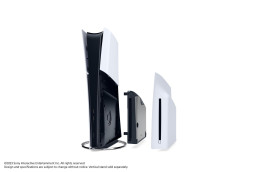
The original PlayStation 5 has 825 GB of storage space. The storage of the Slim has been upgraded to 175 gigabytes, which ensures that the entire storage is 1 terabyte. In practice, due to the operating system, this will leave around 800 GB for games and other media.
Just like the current PlayStation 5, it is possible to expand the storage space with a compatible SSD.
Size and weight PlayStation 5 Slim
The name already gives it away a bit, but the PlayStation 5 Slim is smaller and lighter than its predecessor. We have listed the different versions:
PlayStation 5 (original) with disc drive: 4.5 kilograms with dimensions of 39 x 10.4 x 26 centimeters
Playstation 5 without disc drive (original): 3.9 kilograms with dimensions of 39 x 9.2 x 26 centimeters
Playstation 5 Slim with disc drive: 3.2 kilograms with dimensions of 35.8 x 9.6 x 21.6 centimeters
Playstation 5 Slim without disc drive: 2.6 kilograms with dimensions of 35.8 x 8 x 21.6 centimeters
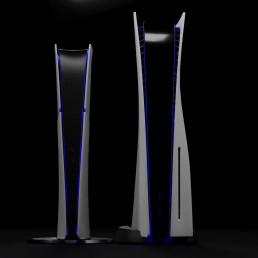
Standard PlayStation 5 Slim
Something that is missing from the PlayStation 5 Slim is the multifunctional stand – this was included with the original PlayStation 5. The console only comes with a horizontal stand to place the console. If you want to place your PlayStation 5 Slim upright, it costs 29.99 euros.

USB connections
Another difference that may not be noticeable is that PlayStation 5 Slim now has two USB-C inputs on the front, and only one USB-A input on the back of the console. The original PlayStation 5 has one USB-C input and one USB-A input on the front, with two USB-A inputs on the back. It is still unclear what kind of charging cable comes with the console.
All PlayStation 5 Slim prices at a glance
PlayStation 5 with disk drive: 549.99 euros
PlayStation 5 without disk drive: 449.99 euros
Separate disk drive: 119.99 euros
Stand to put upright: 30 euros
In addition to these changes, the PlayStation 5 Slim remains graphically identical to its predecessor. According to Sony’s information, the CPU, GPU and RAM remain the same, although there are rumors of a Playstation 5 Pro for the fourth quarter of 2024.
Hardware | Asus unveils ProArt RTX 40 GPUs for content creators
Under the ProArt banner, Asus now also produces video cards for content creators, starting with an RTX 4080 and RTX 4070 Ti.
Asus announced itself through press releases and an article on the Edge Up blog. Asus’ ProArt subsidiary, intended for content producers, originally started with a production monitor scion, but soon expanded to include peripherals, all-in-one systems and motherboards. Very soon, the first video cards will also be added to the range.
Entirely in line with the ProArt promise, the first GPUs are also relatively high: Nvidia’s RTX 4080 (suggested price 1,399 euros) and RTX 4070 Ti (from 909 euros) are not the least graphic processors, with demanding PC gamers as the main target group. Only Nvidia’s top model, the RTX 4090, offers a bit more computing power.
In contrast to exuberant gaming models, the ProArt cards look quite sober. The almost black chassis is straight-lined, with only some typical, gold-colored ProArt accents to stylize the whole. Both the RTX 4080 and the RTX 4070 Ti stick to a maximum thickness of two and a half PCI slots, with a length of 300 millimeters at the latest. There is, somewhat naturally, no RGB lighting here.
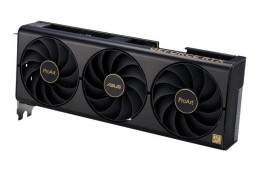
Like most modern gaming cards, the ProArt GPUs stick to a three-fan cooling setup. However, these would be designed and modified to produce a maximum of 44 decibels of noise, with of course also a ‘0 decibel mode’, which completely disables the fans at lower workloads.
It is still unclear when exactly the ProArt cards should be available in the Benelux, let alone what the exact suggested retail price will be. Early versions of the cards will be exhibited these days at the 100th anniversary of the NAB Show in Las Vegas, a recurring trade show for (television) producers and other content professionals. On the same exhibition floor, Asus will also be demonstrating new ProArt displays with microLED panels and the latest ProArt motherboards.
Hardware | Seagate Unveils Star Wars SSDs with Lightsaber Heat Spreaders
Storage manufacturer Seagate now also offers Star Wars variants of FirceCuda SSDs, including three lightsaber-themed heat spreaders.
The SSD in question is the same FireCuda PCIe 4.0 gaming model that the manufacturer has been betting on for some time; an M.2 drive with maximum read speeds of up to 7,300 MB/s. In the Star Wars theme, the SSD comes in volumes of 1 TB and 2 TB, where previous FireCuda models also came in 500 GB versions.
As a unique addendum, the so-called ‘Lightsaber Collection’ edition invariably comes with three unique heat spreaders, respectively in Obi-Wan Kenobi, Darth Vader and Luke Skywalker themes. Each heatsink places its iconic lightsaber right on top of the SSD, with a strip of freely adjustable RGB diodes for lighting.


Seagate seems to offer the world’s first official Star Wars-themed SSDs with the unique collaboration. Incidentally, this novelty does not characterize the first Star Wars hardware in general: at the end of 2017, for example, Nvidia launched two more Star Wars-style Titan Xp video cards, with a green-lit Jedi Order and a red-hot Galactic Empire version, respectively.
Hardware | Asus controller for Xbox and PC has built-in OLED screen
Asus has unveiled the ROG Raikiri Pro, a controller for Xbox and PC with a built-in OLED screen.
The built-in 1.3″ OLED screen is located at the top of the front of the controller. You can, for example, play animations or display the battery percentage of the battery.
It is also possible with the controller to reprogram buttons on the front and back of the controller. The triggers can also be fixed. You can switch between different profiles to quickly change the control mode, for example depending on which game is being played. Reprogramming the buttons is done through the ROG Armory Crate software. More details can be found on the official website.
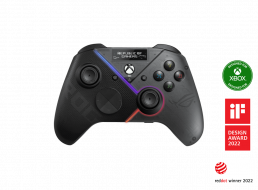
Asus has used an official Xbox license for the ROG Raikiri Pro, but the controller can also be used on PC. It is not yet known when the controller will be released exactly and how much it will cost, although it is clear that the Raikiri Pro should be available sometime this quarter.
Hardware | AMD unveils first RX 7000 GPUs for laptops
AMD has unveiled the first mobile variants of its RX 7000 GPUs at CES 2023.
The first mobile chips on the new RDNA 3 architecture were part of AMD’s extensive CES 2023 presentation. Just like competitor Nvidia, AMD unveiled a scion of laptop GPUs around the tech fair, although AMD does this less widely. For the time being, the mobile RDNA 3 range is limited to four GPUs, which according to their denominators mainly serve the middle segment.
The four laptop chips can be divided into two different RX 7600M GPUs, aimed at 1080p games at high frame rates and two RX 7000S GPUs for thinner and light notebooks. The four GPUs share a number of specifications, such as the Navi 33 chipset as a base (204 square millimeters at 5 nm), 8 GB of GDDR6 memory and an Infinity Cache of 32 MB.

AMD’s Radeon RX 7600M XT is currently the fastest mobile RDNA 3 GPU, with 32 computing units and 2048 shader processors. According to AMD, this laptop model should be able to compete with the desktop version of Nvidia’s GeForce RTX 3060, also with 12 GB of video memory. It is striking that AMD’s heaviest laptop chip draws a maximum of 120 watts, where the RTX 3060 manages with 170 watts.
AMD benchmarks show that the RX 7600M XT achieves up to 40 frames per second more than the RTX 3060 in 1080p games. The biggest lead can be found in games such as The Witcher 3, Hitman 3 and Borderlands 3; in PUBG: Battlegrounds, AMD admits that the RTX 3060 (12 GB) is still slightly faster than the new laptop GPU.

The non-XT model of the RX 7600M and the two S-GPUs each make up their own slightly weaker tweaks of the Navi 33 base. The GPUs all come with lower (maximum) power consumption, but still promise higher frame rates in 1080p scenarios.
For example, the RX 7700S would average 147 frames per second in Death Stranding and 142 fps in Shadow of the Tomb Raider. Compared to the previous RX 6700S (as well as with 8 GB GDDR6), the RX 7700S offers up to 30 percent better performance.

Aside from performance in games, each of the mobile RX 7000 GPUs also come standard with AV1 encoding and decoding, just like their larger RX 7900 desktop brethren.
In addition to the first four mobile RDNA 3 GPUs, AMD is also expanding the RX 6000 range (RDNA 2). The RX 6550M, RX 6550S and RX 6450M each form a new mobile GPU based on the Navi 24 chipset with 4 GB of GDDR6 memory. The new range mainly enriches the lower segment of mobile GPUs
News | PlayStation 5 controller with additional accessibility options revealed
Sony has unveiled Project Leonardo, a PlayStation 5 controller focused on providing more accessibility options.
The company did this during the CES fair that is currently being held in Las Vegas. There is no release date for the controller yet. “More information, such as when we release the product, we will share in the future,” said an article on PlayStation Blog.
Project Leonardo is basically a flat circle that can be laid down, to which players can even add buttons. One can use one or combine two, or one Leonardo with a traditional DualSense controller. In this way, it should be easier for gamers with a physical disability to play PS5 games.
Not only Sony is trying to provide more options for players with disabilities. Microsoft has been making the Xbox Adaptive Controller available for some time now. According to Reggie Fils-Aimé, the former director of the American branch of the company, Nintendo also experimented with such a controller a few years ago.


Hardware | DualSense Edge controller releases January 26
The DualSense Edge will be available from January 26, 2023 and will cost 239.99 euros.
Sony has announced that. The controller will be available on that date for 239.99 euros via direct.playstation.com – only on February 23, the controller will also be offered through a selection of regular stores. Pre-orders for the controller will go live on October 25.
In addition to the controller itself, a braided USB cable is included, as well as a storage bag and several interchangeable buttons and triggers for the controller itself.
Sony unveiled the DualSense Edge at Gamescom last August. There have been rumors for some time that Sony would come up with its own ‘pro controller’, similar to the Xbox Elite controller.
Players can customize the controller to their own play style. Button functions can be set as desired, as well as the sensitivity of the analog sticks and their ‘dead zones’. You can also save different profiles with settings.
The top of the analog sticks can be replaced. There are three different ‘caps’ for the sticks. There are also two sets of buttons for the back of the controller.
Hardware | New system update for PlayStation 5 now available
Sony has released a new system update for PlayStation 5.
Update 22.02-06.02.00 can now be downloaded. According to the official description, the patch should “improve system performance”. There are no further details. It’s exactly the same description as that of the previous PS5 update that came out early this month.
The most recent substantial PS5 update came out in September. This added a sort of folders to sort games in the form of ‘game lists’. The update also added support for 1440P HDMI video.
In related news, Sony Interactive Entertainment Japan Asia has released a new PlayStation commercial that focuses on the console’s games lineup. This will feature (upcoming) games such as God of War: Ragnarök, Final Fantasy 16, Sonic Frontiers, Hogwarts Legacy, The Last of Us: Part 1 and Gotham Knights.
Hardware | Intel shows new NUC 13 Extreme at TwitchCon
At TwitchCon, Intel showcased the new NUC 13 Extreme system. 'Raptor Canyon' will be the most powerful and largest NUC to date.
The complete NUC 13 Extreme system is a PC casewith a volume of 13.9 liters. The largest NUC to date, Intel’s 12th-generation gaming-focused Extreme model, was 8 liters. With the introduction of a larger chassis, it becomes possible for the first time to equip NUC systems with video cards with a thickness of approximately three PCI slots. During the TwitchCon broadcast, a decent RTX 30 video card was inserted into the NUC 13 for demonstration purposes.
The so-called compute element has also been renewed with Raptor Canyon. The mainboard is once again built as a PCIe component, this time incorporating a thirteenth generation Intel Core processor (Raptor Lake). Intel has not yet revealed which (different) CPUs will be used in the new generation of NUC systems. Usually the choice consists of at least two or three different and sometimes unique chips.
During TwitchCon, Intel gave us a look at the NUC 13 Extreme, codename Raptor Canyon
— Charlie (@ghost_motley) October 10, 2022
Larger chassis to support larger GPUs (up-to 3 slot), single PCB connects both GPU and Compute Element, which has been drastically redesigned with improved cooling
Intel says more info soon pic.twitter.com/GZbTNseeg9
NUC systems are usually supplied without a ‘dedicated’ video card, although that may change with this generation. Earlier, Intel already demonstrated NUC systems with Intel Arc GPUs. There is a chance that Intel will soon also offer NUC options that include proprietary Arc video cards. Coincidentally, the Arc A770 desktop card will officially appear tomorrow, the first GPU where Intel also manufactures ‘Limited Edition’ variants.
Intel didn’t say anything about the expected prices of the new NUC systems, let alone the specifications of CPUs or potential GPUs. Further details should follow in the coming weeks; a kick-off for the first NUC 13s will follow soon.



